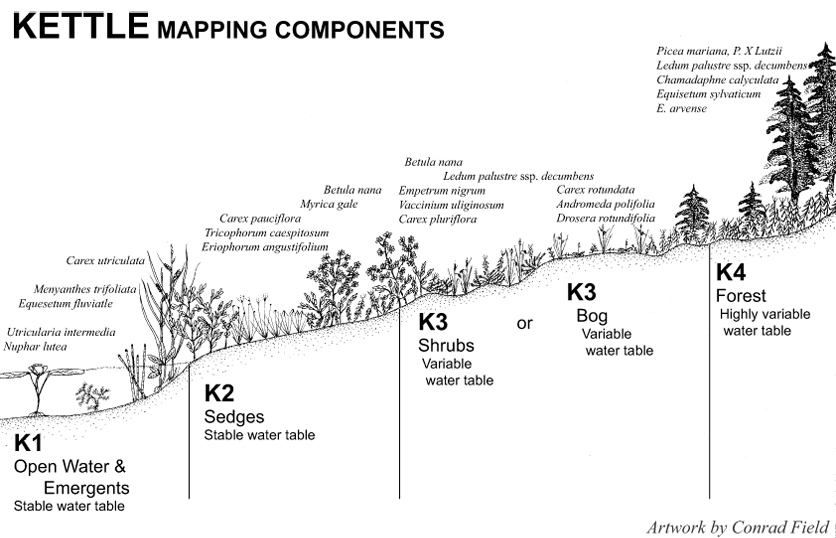
An idealized cross-section of a Kettle wetland showing hydrologic components and typical plants. Drawing by Conrad Field.
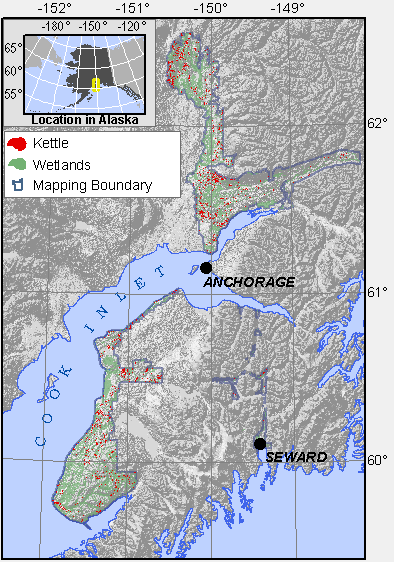
Range of wetlands mapped as Kettles.
Kettle wetlands are peatlands occupying depressions created when ice-blocks entrained in glacial till melted at the end of the last glacial advance (ice-block depressions). Kettles have a wetland or stream connection to Cook Inlet, unlike Depression and Spring Fen wetlands, which also formed in ice-block depressions. Depressions and Spring Fens are surrounded by uplands. Kettles are common and widespread throughout the Cook Inlet Lowlands. They occur on and adjacent to glacial moraines, and gradually grade to Lakebeds along moraine margins, especially on the edge of the moraine that was closer to the former glacier.
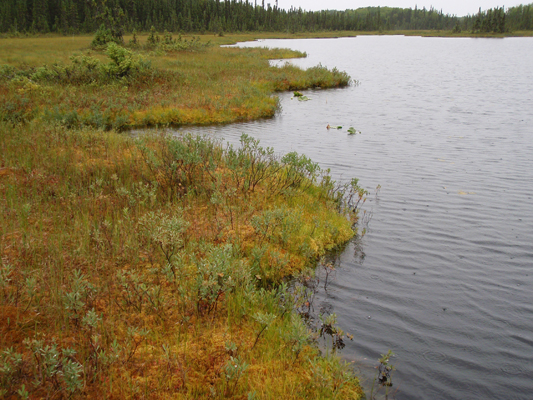
A Kettle south of Big Lake.
| Table 1. Wetland Indicators of Kettle Geomorphic components throughout the Cook Inlet Lowlands. | ||||||||
| Map Component | Peat Depth (cm) | Water Table (cm) | Redox features (cm) | Saturation (cm) | pH | Alkalinity mg/l as CaCO3 | Specific Conductance µS/cm | Plant Prevalence Index |
K1 |
139 (9) | -24 (12) | 0 (11) | 6.4 (50) | 25.9 (10) | 65 (51) | 1.01 (8) | |
K2 |
194 (87) | 3 (97) | 61 (3) | 1 (63) | 5.3 (58) | 17.0 (35) | 84 (52) | 1.44 (87) |
K3 |
169 (115) | 18 (117) | 42 (4) | 5 (61) | 4.8 (62) | 4.3 (48) | 53 (52) | 2.10 (117) |
K4 |
114 (74) | 30 (76) | 36 (21) | 21 (37) | 5.1 (19) | 6.3 (12) | 64 (16) | 2.43 (74) |
Explanation:
- Numbers in parentheses indicate number of samples.
- Peat depth is a minimum, because some sites had thicker peat deposits than the length of the auger used (between 160 – 493 cm).
- Water table depth is a one time measurement. At sites with seasonally variable water tables this measurement reflects both the conditions that year, and the time of year.
- Redox features with deep depths typically indicate deeper peat deposits, which mask redox indicators so the depth corresponds to the peat thickness.
- pH and specific conductance measured in surface water or a shallow pit with a YSI 63 meter calibrated each sample.
- Plant Prevalence Index calculated based on Alaska indicator status downloaded from the USDA PLANTS database, which may use different values than the 1988 list.
NWI and HGM
Kettles fit into the US Fish and Wildlife Service’s National Wetland Inventory Palustrine category. Kettles support a variety of Classes from herbaceous emergents (PEM) to shrubs (PSS) and forest (PFO). The forested subclass is usually needle-leaved evergreen, but occasionally it is mixed needle-leaved evergreen / broad-leaved deciduous. The shrub subclass is usually a mix of broad-leaved deciduous and evergreen. Hydrologic regimes are seasonally flooded/saturated conditions in the PEM subclass (PEME). The hydrologic regime in the shrubby and forested subclasses often does not fit any of the NWI regimes very well because in Kettles PSSs typically and PFOs rarely support standing surface water, and are only saturated to the surface for a sufficient time during the growing season to meet wetland conditions. Due to the short growing season in Cook Inlet Basin, this period of saturation may be only for a few weeks. The NWI hydrologic regime “saturated” requires saturation to the surface for “extended periods during the growing season”. The water chemistry modifier in Kettles is usually acidic and the soils modifier is organic.
The LLWW Hydrogeomorphic classification (Tiner, 2003) would classify most Kettles as Terrene Basin groundwater-dominated throughflow wetlands. When the Kettle is occupied by a central lake, greater than 20 acres and deeper than 6.6 feet, it would be named a Lentic Fringe throughflow wetland. Some may also form the headwaters to small streams, in which case the modifier “headwater” is appended.

Box plots of Plant Prevalence Index in common wetland mapping components. Kettle wetlands (gray) mapped with lower-numbered hydrologic components (K2 vs K4 for example) have lower values for Plant Prevalence Index. Prevalence Index is a good proxy for water table depth and variability. Lower values indicate a water table closer to the surface for a longer portion of the growing season. An Index value equal to one indicates that the plot supported only wetland obligate plants (occur in wetlands greater than 99% of the time under natural conditions). A Prevalence Index value greater than 3 suggests that the plot may not be a wetland for jurisdictional purposes. Prevalence Index values in Kettle wetlands are wide ranging, occasionally exceeding PI = 3 in areas mapped as forested (K4) or shrubby (K3). The wide-ranging values suggest that precipitation, rather than groundwater, dominates inputs, and that water tables fluctuate widely during the growing season. For example, although the median values of wetlands mapped as K2 or K3 are similar to the median values of wetlands in other geomorphic settings that are also mapped using the hydrologic component number 2 or 3 (e.g. DW2 or DW3, the equivalent Lakebed component to K3 is LB4), Kettles more often show higher values for PI. This may be due to generally lower inputs to Kettles from groundwater, which would tend to stabilize water levels throughout the growing season, and higher reliance on precipitation, which can be highly variable seasonally. Further, Kettles often occur at higher elevations in their local watersheds, suggesting a reduced potential for contributions of discharge from up-gradient watershed elements.
Prevalence Index is calculated from the percent cover and the wetland indicator status of each plant found in a wetland plot. Lower values indicate a higher prevalence of plants assigned a wetland indicator status of obligate or facultative. Indicator status is assigned nationally, by state, and by regions within states. Prevalence Index may be a better descriptor of the variability of the water table than one-time measurements of the actual position of the water table. Measurements are often made before the water table has fully equilibrated, and are dependent on antecedent conditions. However, if Indicator Status is accurately assigned the plants present will integrate long-term average conditions.
In the box plots, yellow boxes enclose the first through third quartile (where 50% of the data values lie); the gray bar is the median, and the whiskers extend to the last value within 1.5 times the inner quartile range. Values lying beyond 1.5 times the inner quartile range are plotted as hollow circles. The number of samples for each map component is given across the top.
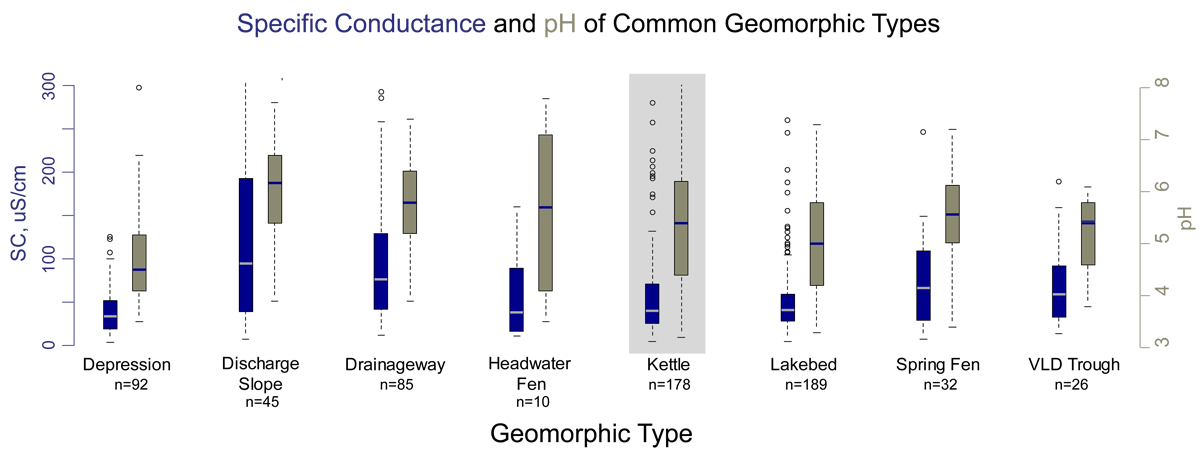
Box plots of specific conductance (SC- blue) and pH (brown) in the common geomorphic types. A few values for specific conductance greater than 300 micro-Siemens/cm are not shown. Kettle wetlands have intermediate values of SC and pH; between common values found in Lakebeds and values in Drainageways. Lakebeds are frequently fed primarily by precipitation, while Drainageways have a stronger ground water influence. The intermediate values suggest that precipitation is a major component of water budget inputs, but that discharge from ground water may be important to many Kettles.
In box plots, the boxes enclose the first through third quartile (where 50% of the data values lie); the horizontal bar in the box is the median value, and the whiskers extend to the last value within 1.5 times the inner quartile range. Values lying beyond 1.5 times the inner quartile range are plotted as hollow circles.
Soils and Plant Communities
| Table 2. Common soils and plant communities found in Kettle wetlands. | ||
| Map Component | COMMON SOILS | COMMON PLANT COMMUNITIES |
K2 |
STARICHKOF
HISTOSOLS |
Trichophorum caespitosum – Trichophorum alpinum
Trichophorum caespitosum – Carex pauciflora |
K3 |
STARICHKOF
HISTOSOLS |
Sphagnum spp. – Ericaceae
Carex pauciflora – Betula nana |
K4 |
STARICHKOF
HISTOSOLS |
Picea mariana / Ledum palustre ssp. decumbens |
| HISTOSOLS are any organic soils greater than 40 cm deep. | ||
Cation Chemistry
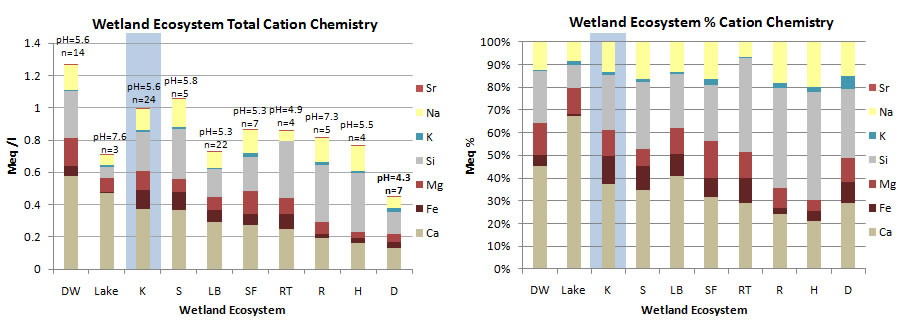
Cation chemistry by Geomorphic Component. Kettle wetlands (highlighted in blue) have the third highest cation concentrations compared to other Geomorphic Components, indicating a strong groundwater influence on porewater chemistry. Kettles have the highest cation concentrations of any of the ice-block depression wetlands. The other ice-block depression wetlands (Spring Fens and Depressions) are isolated. Although calcium and silicon show the greatest concentrations, magnesium and iron concentrations in our area are high for natural waters. DW = Drainageway, K = Kettle; S = Discharge Slope; LB = Lakebed; SF = Spring Fen; RT = VLD Trough; R= Riparian; H = Headwater Fen; D = Depression.
Samples were collected from a surface pool where possible, otherwise from a separate shallow pit excavated to just below the water table. All samples were filtered through either a 0.2 micron filter using a disposable syringe, or pumped through a 0.45 micron filter using a peristaltic pump. Samples were acidified with ultra-pure nitric acid and kept cool until analysis on a direct current plasma spectrometer to about 5% accuracy (except K, 10-20% accuracy).
Kettle Wetland Hydrologic Components:
K1: Kettle pond. If larger than 20 acres, the kettle is classified as a Lake.
- NWI: PEM2H
- HGM, LLWW: Terrene Basin groundwater-dominated Throughflow (headwater)
K2: Water table at or very near the surface, often sedge-dominated.
- NWI: PEM1Eg
- HGM, LLWW: Terrene Basin groundwater-dominated Throughflow (headwater). When adjacent to a central lake: Lentic Fringe Throughflow (headwater).
K3: Deeper, more variable water table, often shrub dominated.
- NWI: PSS1,3&4Bg
- HGM, LLWW: Terrene Basin groundwater-dominated Throughflow (headwater)
K4: Seasonally variable water table, forested.
- NWI: PFO4Bg
- HGM, LLWW: Terrene Basin groundwater-dominated Throughflow (headwater)
| Table 3. Summary of Cook Inlet Kettle Map Unit occurrence. | ||||
| Map Unit | N | Hectares | % Polygons | % Area |
| K1 | 428 | 977 | 1.78 | 0.52 |
| K12 | 59 | 330 | 0.25 | 0.18 |
| K12c | 1 | 8 | 0.00 | 0.00 |
| K13 | 21 | 101 | 0.09 | 0.05 |
| K1-3 | 219 | 1395 | 0.91 | 0.74 |
| K14 | 1 | 0.5 | 0.00 | 0.00 |
| K1-4 | 36 | 257 | 0.15 | 0.14 |
| K14d | 1 | 3.6 | 0.00 | 0.00 |
| K1c | 16 | 85 | 0.07 | 0.05 |
| K1d | 3 | 18 | 0.01 | 0.01 |
| K2 | 390 | 1257 | 1.62 | 0.67 |
| K21 | 111 | 602 | 0.46 | 0.32 |
| K21c | 1 | 0.5 | 0.00 | 0.00 |
| K21d | 1 | 5.4 | 0.00 | 0.00 |
| K23 | 475 | 2155 | 1.97 | 1.15 |
| K23c | 1 | 1.11 | 0.00 | 0.00 |
| K23d | 4 | 16 | 0.02 | 0.01 |
| K24 | 25 | 69 | 0.10 | 0.04 |
| K2-4 | 194 | 1058 | 0.81 | 0.56 |
| K2-4c | 1 | 2 | 0.00 | 0.00 |
| K2-4d | 2 | 4.0 | 0.01 | 0.00 |
| K2c | 2 | 11 | 0.01 | 0.01 |
| K3 | 900 | 2031 | 3.74 | 1.08 |
| K31 | 17 | 58 | 0.07 | 0.03 |
| K31d | 1 | 1 | 0.00 | 0.00 |
| K32 | 402 | 1460 | 1.67 | 0.78 |
| K32d | 1 | 1.2 | 0.00 | 0.00 |
| K34 | 654 | 2730 | 2.72 | 1.45 |
| K34d | 2 | 4.8 | 0.01 | 0.00 |
| K3d | 7 | 3.0 | 0.03 | 0.00 |
| K4 | 1141 | 5813 | 4.74 | 3.10 |
| K41 | 2 | 0.8 | 0.01 | 0.00 |
| K42 | 25 | 119 | 0.10 | 0.06 |
| K43 | 589 | 3164 | 2.45 | 1.69 |
| K43d | 2 | 9.3 | 0.01 | 0.00 |
| K4d | 22 | 77 | 0.09 | 0.04 |
